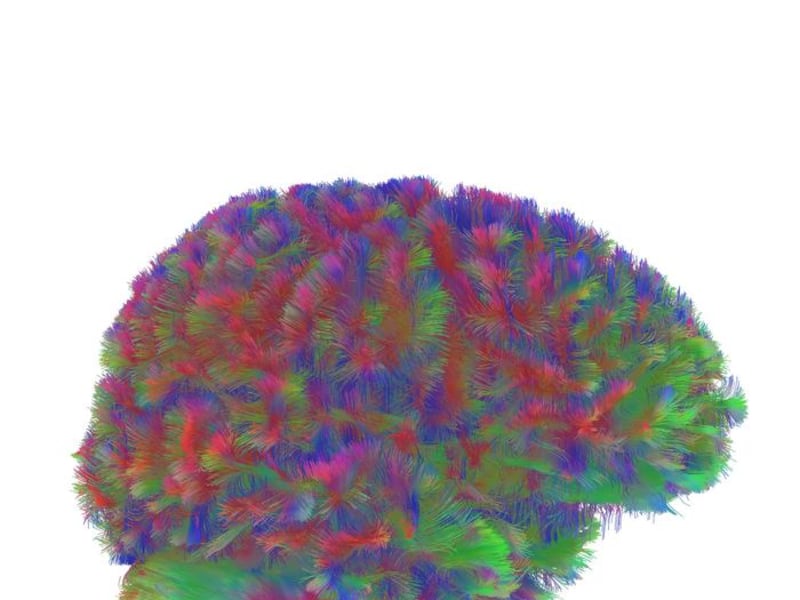- Brain development involves five distinct epochs across a human lifespan.
- Late aging initiates declines in connectivity around age 83 and alters region reliance.
- Wiring differences potentially link to various neurodevelopmental and mental health challenges.
You’ve likely heard that the brain isn’t fully developed until someone’s around 26 years old. But did you know that the brain rewires itself throughout the lifetime?
University of Cambridge neuroscientists led a study that used magnetic resonance imaging to discover the brain doesn’t gradually rewire itself. They found the brain has distinct “epochs” to its structure, required to “support different ways of thinking while we grow, mature and ultimately decline,” per a news release on the study, which was published in the journal Nature Communications.
“We know the brain’s wiring is crucial to our development, but we lack a big picture of how it changes across our lives and why,” said Dr. Alexa Mousley, a Gates Cambridge Scholar who led the research. “This study is the first to identify major phases of brain wiring across a human lifespan.”
Researchers in Cambridge’s MRC Cognition and Brain Sciences Unit compared brains of 3,802 people aged from birth to 90 using datasets of MRI diffusion scans mapping neural connections by watching how water molecules move through brain tissue.
They found five “broad phases of brain structure in the average human life, with four distinct turning points during which brains reconfigure.”
According to the researchers:
- Childhood brain topology reaches a turning point at age 9, transitioning to the adolescent phase.
- The adolescent phase lasts right up to age 32, on average.
- In the early 30s, brain wiring shifts to adult mode, which lasts more than three decades.
- At around age 66, “early aging” starts.
- At about age 83, “late aging brain” takes shape.
“These eras provide important context for what our brains might be best at, or more vulnerable to, at different stages of our lives,” Mousley said in the Cambridge news release. “It could help us understand why some brains develop differently at key points in life, whether it be learning difficulties in childhood, or dementia in our later years.”
Babies are born with an abundance of synapses, which are the connections between neurons. During infancy through childhood, those are “whittled down, with the more active ones surviving.”
While those connections are rewiring, gray and white matter volume expands so that the distance between gray matter and inner white matter — cortical thickness — peaks and the cortical folding that creates the brain’s distinctive ridges stabilizes.
What’s your brain doing?
By age 9, the first “turning point,” the brain is changing in cognitive capacity and the risk of mental illness increases.
During the adolescent period, white matter grows in volume “so organization of the brain’s communication networks is more and more refined.” The connections in specific regions and fast communication across the whole brain become efficient, which the researchers say matters to enhanced cognitive performance.
Mousley said that short neural paths are more efficient and “the adolescent era is the only one in which this efficiency is increasing.”
Around age 32, the development peaks, forming what the researchers call the “strongest topological turning point” of the lifespan. It’s the time of the most directional wiring changes and overall shifts.
The long adult epoch that begins about then shows no major turning points for several decades, lending credence to the idea from other studies that there’s a “plateau in intelligence and personality.” During this period, as well, brain regions slowly become more compartmentalized.
The next shift, around 66, is more subtle. "The data suggest that a gradual reorganization of brain networks culminates in the mid-60s,” said Mousley. “This is probably related to aging, with further reduced connectivity as white matter starts to degenerate."
It’s at that point that risk of health conditions like high blood pressure, which can affect the brain, becomes bigger.
The last brain rewiring epoch is around 83, marked by declines in brain connectivity and increased reliance on certain regions of the brain.
Senior author Duncan Astle, professor of Neuroinformatics at Cambridge, said that a lot of the neurodevelopmental, mental health and neurological conditions are linked to the brain’s wiring. “Indeed, differences in brain wiring predict difficulties with attention, language, memory and a whole host of different behaviors.”
Knowing the major turning points could help identify “when and how its wiring is vulnerable to disruption,” he said.
Another look at rewiring
It’s not the only new study of rewiring. Ohio State University released a study earlier this month that showed brain connectivity patterns can predict the mental functions across the entire brain.
In a release on the study, lead author Kelly Hiersche, a doctoral student in psychology at Ohio State University, said, “We found evidence suggesting that connectivity is a fundamental organizational principle governing brain function, which has implications for understanding what happens when things go wrong in the brain.”
The analysis of more than 1,000 brain scans showed a “strong and consistent link between the brain’s wiring and its activity across all regions and cognitive domains. In essence, a region’s connectivity pattern could predict whether it would be active or inactive during a wide range of mental activities, from conversation to visual recognition to decision-making.”
The study was published in the journal Network Neuroscience.


